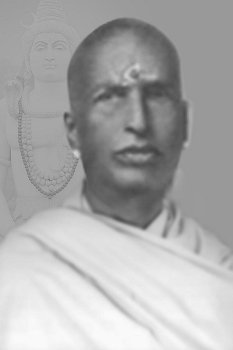ARTICLE
Brahmasri Paruthiyur Krishna Sastri
- C.R. Kaushik
December 2008
updated September 2017

When
we think of Lord Sri Rama in epic poetry form we can think of Valmiki,
when we think of Sri Rama in music form, our mind automatically
remembers Thyagaraja Swami, and when we think of Sri Rama in story form,
one will remember Ramayanam Sri Krishna Sastri. Sastri was a
comprehensive interpreter of the Valmiki Ramayana slokas and his
Ramayana stories are noted
for the fascinating way in which he portrays the life and virtues of Sri Rama,
enshrining the ideals that are ageless, teaching the lessons that are timeless,
telling the stories that are enduring, and depicting the truths that have withstood
the test of time.
Paruthiyur Sri Krishna Sastri' (1842-1911), revered as 'Paruthiyur Periyava'
'Pravachana Pithamaha' and 'Ramayanam Sastrigal' was a pioneer of Hindu
religious discourses. He was considered the greatest exponent of the Ramayana,
who had traveled all over India and had conducted discourses in various subjects
spreading the knowledge. He was a versatile Sanskrit scholar well versed in
Vedas, who was good with ragas and had conducted many Harikatha
Kalakshepa, narrating story with music in a grand style. With good knowledge of
the Sastras, he quoted from Pracheena Vyakyanas like Govindaraajeeya Kavyas
and Thilaka Vyakyanas in his lectures and his Pravachanas made him most
famous. Sastri was an avid connoisseur of Hinduism, a Philanthropist and above
all he was the greatest Bhakta with immense devotion to Sri Rama.
EDUCATION
Educated under prominent teachers like Sengalipuram Vaidyanatha Dikshitar
Mutthannaval (1830-1893) and Mahamahopathyaya Mannargudi Raju Sastri
(1815-1903), in Religion, Spirituality, Veda, Vedanta and Hindu scriptures. Sri
Krishna Sastri had received Nama Sangeertan lessons and Mantropadesam
from Marudhanallur Sadguru Swamigal, an ardent devotee of Lord Rama and
Vedanta Shravanam from 'Alangudi Periyava' Sri Swayamprakashananda
Saraswathi (1862-1935), an ardent devotee of Lord Narasimha, who was a
poineer of Bhagavata Sapthaham.
MANTROBADESAM
Sri Krishna Sastri had received 'Mantropadesam' from Marudhanallur
Kodandarama Swamigal. Ever since then everything was Rama and what he did
all his life was Ram Nama smarana and Mantra Japam. Since his younger age
he always wanted to build a Rama Temple. Villagers have noticed little Krishna
playing with his friends, building temples and tanks out of sand on the banks of
the Kaveri River.
CONTRIBUTION TO SOCIETY
Ramayanam Sastri considered 'A Temple Saved Is as good as a Temple
Built'. Sastri's life was dedicated to building and renovating temples, philanthropy,
doing Dhana-Dharma and helping the needy, feeding the poor, singing and
talking about the glories of the Lord, thereby inducing bhakti and dharma in his
large audiences.
SCHOLAR'S PERCEPTION
Kanchi Acharya, Mahaperiyava Sri Chandrasekharendra Saraswati says"Brahmasri Paruthiyur Krishna Sastri fed Rama Bhakti to thousands of people, he
had conducted Sri Rama Pattabhishekam over a hundred times, his Rama
Temple and Tank constructions, all these make his Charithram (History) and
Namasmaranam (chanting of Holy name), would hopefully be a Maargadharshi
(showing the way) to achieve Rama Anugraha.
Swami Dayananda Saraswathi of Arsha Vidya Gurukulam says "Paruthiyur
Krishna Sastri was a pioneer in Ramayana Pravachana who paved way for other
Pravachana Karthas like Sengalipuram Dikshitars to follow. Sastri was not only a
scholar he was a devotee. This combination of vedic scholarship, devotion and
humility make a person command reverence from everyone who comes to know
him".
Over a hundred years ago in 1911, Thai month Krishna Paksham Dwadasi day,
the same Thithi (Calendar day) when his Guru Sri Muthannaval attained siddhi,
this Mahaan had a Viswarupa Darshan of Paruthiyur Rama and attained Mukti
through 'Brahma Kapala Moksha'.
C.R. Kaushik a freelance writer
belongs to a Sastriya family of
scholars and educationalists. Indology, Archaeology, Indian Art,
Culture, Traditions, Hinduism, Temples, Spirituality and Fine Arts are
some of the author's favorite topics. |